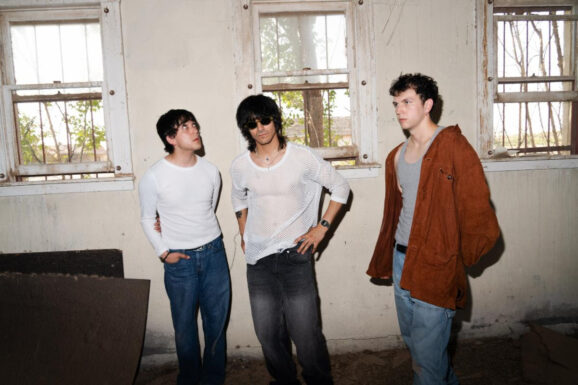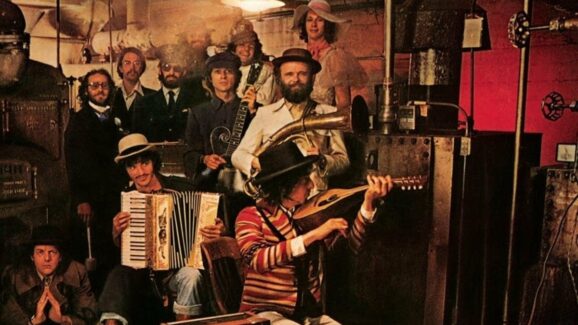Grammy Award-winning guitarist Eric Krasno (Lettice, Soulive) and Grammy Award-winning drummer Stanton Moore (Galactic, Garage-a-Trois) released the first album under their new banner of The Krasno/Moore Project in March, titled Book of Queens, which arrives on vinyl and CD later in the year. This instrumental project, forming a trio with organist Eric Finland, consciously sets out to pay tribute to female songwriters and artists through picking songs from a wide range of eras to translate into the Project’s particular style.
Krasno and Moore have shared the stage many times across the past twenty-five years, and Krasno has also played alongside Finland for many years. That alone was an encouraging element that contributed to their mostly live sound on the album, recorded Levon Helm Studios in Woodstock, New York, which was mixed by Jim Scott (Tedeschi Trucks Band, Wilco). The artists whose music was chosen for Book of Queens include Amy Winehouse, Nina Simone, Billie Eilish, Sharon Jones, H.E.R, Kacey Musgraves, Brittany Howard, Peggy Lee, and Aretha Franklin.
I recently spoke with Eric Krasno, who was fresh off a tour of bringing these songs to audiences, about the development of the album and what insights about the music the live show is currently bringing to light.
Was there a time when you were just considering working together and weren’t sure exactly what music you’d focus on?
What started as kind of just an idea turned into a much bigger thing. That also happened in terms of us just having fun with the material. Being mostly an instrumental group, we can explore these melodies and changes, and add all these different grooves to it. It’s been a fun process.
I think for a lot of people, they would find it very challenging, so I find the results really impressive. When you’re working with instrumental music, for instance, you have to decide what you’re going to do with those vocal lines, and I feel like I can see the ways in which you created new orchestrated and created new conversations.
Right. That part was challenging for me, personally. I would also go through playlists of songs, and be aware that there is such a huge wealth of music to cover, since there are so many great female artists to choose from. I would ask myself, “What can I translate to the guitar that gives it a unique take?” I’ve always tried to emulate singers on the guitar. It’s always been kind of my thing. My favorite guitar players growing up were guys that did that, like B.B. King. They were guys who didn’t necessarily go for a lot of notes but emulated that singer emotion.
Then there was also the question, “What songs can we translate to our sound without making it seem cheesy?” The first one that I tried was “Slow Burn”, which is a Kasey Musgraves song. I was thinking, “Let’s choose some songs that aren’t just soul songs, since everyone is going to picture that as what we would cover.” We knew we were going to land on Aretha Franklin and Nina Simone, of course. You could make ten albums with just Aretha.
But we looked for modern artists that we could cover and would translate well. Billie Eilish was another one. It was also about paying tribute to artists that I like who are doing interesting, soulful music. The fun thing is that now we have so many songs we want to do that I feel like we could do ten volumes of this. When you have great songs and great melodies, it’s really about translating them the best you can.
When I was looking through the songs on the album, I actually looked up their original release dates, since I thought that some of them were quite recent, and I was right. We’re talking about 2018, 2019. I like the breadth of both genres and time periods. Even the older stuff is particularly relevant right now, in terms of specific songs, like Nina Simone’s song.
Yes, we talked about that. It all came about because of Stanton and I sitting with our wives, talking. We have to tread lightly because we’re not females, and weren’t sure how this concept might work. But they were both super supportive of the idea to shine a light on female artists. They also said, “Don’t do the standard songs. Think outside the box.” It’s funny, because now that we play shows, we are aware that half of the songs in our set are by contemporary female artists. But there’s also Amy Winehouse and Sharon Jones, who I got to play with a bunch. It’s good to pay tribute to my generation, too.
It was pretty natural, because even though we never got a chance to rehearse, and sent things via Zoom, we were able to conceptualize our own parts. I’d present a guitar part in a certain key, and they’d give feedback. That was a very modern way of doing arrangement, but once we got into the studio, it was completely old-school. We didn’t even have headphones on. We did maybe two or three takes of each thing live in a room. I did a couple of overdubs with a rhythm guitar. That approach was actually really refreshing because I Produce so much music and I make so many records, and I haven’t done it that way since the beginning, since Soulive days.
I heard that you recorded in a great location, too.
Yes, we got to record it at Levon Helm’s studio, in the barn there, which has so much history. It’s such a great live room. We did three days, and the third day, we played a show. Day one, we set up like we were playing a show. The only audience was engineers and a couple of friends, but it was the same. Then, when we actually did the show, we didn’t talk too much about it, aside from deciding which songs we’d play, and which songs we’d insert from Stanton’s catalog and my catalog.
What naturally happened was that we both started taking on a storyteller kind of thing. For Stanton’s song, he talked, and for my song, I talked. It created this storyteller kind of vibe for this show, talking about why we each chose the songs. There was a story behind every song. It became something bigger really naturally. As we went on this tour, that developed even more. We’d have this banter, and Eric Finland, our organ player, would also talk a little bit. At this point, for a lot of reasons, this makes sense. We’re older, we’re broadening our style, and it’s a showcase for more of the dynamics we can offer. We’re doing both slower songs and faster songs and I really like that about this project.
You both have a lot of material, too, at this point to choose from to add to the live show.
We have so much material from over the years from the different projects that we’ve done so when we get together, there’s a cool cross-section of fans who come out. That makes me feel like we’re aging in a good way. [Laughs] That we’re mature as musicians.
This album is so intentional and so much thought has gone into the song choices that it’s great that you’re able to talk about the songs a little when you’re performing them. That’s the whole point, to spotlight the songs. We need more space in life for music conversation and sharing information about music with each other. The educative aspect is really helpful.
It’s huge. It’s something that I would enjoy. I didn’t realize how much other people would also enjoy that. I love to hear the backgrounds behind songs that I listen to, and it also separates the live experience from just listening to a record. If you go to see James Taylor and he talks about the origins of the songs, that’s my favorite part. It’s something newer artists don’t necessarily need to do, and some bands might not be as natural a setting as others, but because of how this project came about, this feels natural.
I meant to ask you about how the combination idea came about to have you, and Stanton, and an organ player, Eric Finland. What is it about that format that appealed to you guys?
Every year at Jazzfest, Stanton and I always do an organ trio thing. There are a lot of appealing things about it. One thing is that I think the Hammond Organ is such a tasteful instrument. When you cover songs and you use a really clean piano sound and a saxophone, I feel like it instantly goes the wrong way. I always feel like the organ has such a dynamic range where you can play really soft, beautiful stuff, but it can also be really aggressive. The organ has so many things that it can do. The biggest thing, too, is that I’ve been playing with Eric Finland in different capacities for the last five or six years, and he just fit so naturally. We weren’t sure how we were going to do it.
We thought an organ would fit, but when he came into the picture, he instantly got the concept and was sending us voice memos. He just jumped in, creatively, and that’s just what he does. The cool thing is that, when we’ve been on tour, we’ve had different guest artists sit in, like bass players, and horn players, so the set-up leaves things open in terms of guest artists. That’s why it’s called a “project”, because I feel like it could evolve and change.
That’s some really cool potential for building things out. Are you expanding on the songs further than you do on the recorded versions in your live performances?
That’s the part that I get really excited about. When we’re performing, ideas start to form. That’s when the band becomes a band. You’re understanding the decisions that other musicians are making and supporting them in that moment. That’s where you get the whole idea of Jazz. We’re kind of riding that line because we’re using these songs that are kind of Pop songs, and turning them into these improvisational explorations as well.
That probably reveals different relationships between these songs that you might not have noticed before as they get played in different combinations.
That part alone has been the most mind-blowing thing. Also, just the crowd reactions, since you don’t know which ones are going to be the ones that the crowd responds to. Sometimes our tendency is not to choose slow songs for the live show, but on the first night of the tour, we played “Natural Woman.” It seemed super-slow, but as we started playing it, the whole house went crazy. When we got to the chorus, not one person it the house wasn’t singing it at the top of their lungs. We almost didn’t include that one! I thought it was too obvious, but Stanton said, “We’ve got to do this.” That was by far the biggest reaction. “Slow Burn” also gets a big reaction. Sometimes we don’t realize how broad the audience’s tastes may be.
There are also songs that have become our favorites to play that we may not have realized right away. “Carried Away” is one of them because Stanton has this really interesting groove and he talks about it in the show. He brings people into what he’s doing and I think bringing people into it makes them feel like part of it. That’s the nature of the whole jam band world, though I’ve stayed away from that word. The fans in that world love being a part of a unique experience and want you to change your setlist and explore every time they see you, and that’s also what we want to do!











